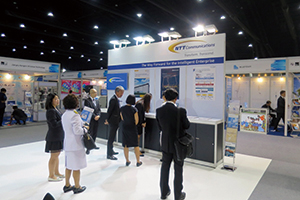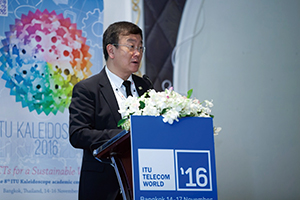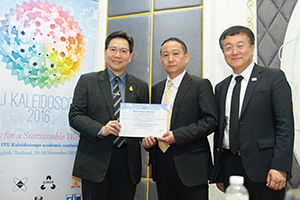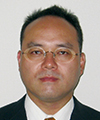 |
|||||||||
|
|
|||||||||
|
Global Standardization Activities Vol. 15, No. 4, pp. 57–60, Apr. 2017. https://doi.org/10.53829/ntr201704gls Report on ITU Telecom World 2016 and ITU Kaleidoscope 2016AbstractITU Telecom World 2016 and the eighth ITU Kaleidoscope academic conference, both of which are organized by the International Telecommunication Union (ITU), took place November 14–17, 2016, at the IMPACT Exhibition and Convention Center, Bangkok, Thailand. With the demise of His Majesty King Bhumibol Adulyadej of Thailand in October, ITU Telecom World was formally opened in a solemn atmosphere by Her Royal Highness Princess Maha Chakri Sirindhorn, second daughter of the late king. This article gives an overview of the exhibits and discussions at the ITU Telecom World and the accompanying Kaleidoscope academic conference. Keywords: ITU Telecom World, ITU Kaleidoscope, ICT 1. Overview of ITU Telecom World 2016ITU Telecom World 2016 was a four-day event organized by the International Telecommunication Union (ITU) and attended by some 8800 participants. It brought together some 250 exhibitors from 37 nations and 173 speakers from 56 nations. Over 330 information and communication technology (ICT) leaders from 90 countries, representing both the public and private sectors, took part in the discussions. 1.1 Overview of roundtables and other main meetingsFollowing the opening address by Her Royal Highness Princess Maha Chakri Sirindhorn, ITU Secretary-General Houlin Zhao, the Prime Ministers of Luxembourg and Vanuatu, the Crown Prince of Tonga, the Deputy Prime Minister of Thailand, and others gave speeches. In the morning of Day 2, an Economic and Industry Roundtable was held with senior executives of telecommunications operators, vendors, and financial organizations in attendance. In the afternoon of Day 2, a Ministerial Roundtable took place with participation by Thailand, Vanuatu, Bahamas, Bangladesh, Belarus, Cambodia, Côte d’Ivoire, Samoa, Hungary, Iran, Japan, Nigeria, and Switzerland. The meeting was chaired by the Deputy Prime Minister and Acting Minister of Digital Economy and Society of Thailand. Representing Japan was Vice-Minister for Policy Coordination Shigeki Suzuki. He stressed the importance of strengthening access networks (including making overseas investments), pursuing innovation using Internet of Things (IoT) and big data, and ensuring the security and free flow of information. 1.2 Overview of exhibitionThere were 14 country pavilions—7 from Africa (Kenya, Ghana, Rwanda, Nigeria, Madagascar, Zimbabwe, and Senegal), 6 from Asia, the host region (Iran, Japan, China, South Korea, Malaysia, and Thailand), and Azerbaijan. Exhibitors in the Japan Pavilion were NTT Communications, Internet Initiative Japan, Japan Battery Regeneration, National Institute of Information and Communication Technology (NICT), and Nextech. Japanese exhibitors in the ITU Telecommunication Standardization Sector (ITU-T) booth were NEC, OKI, NICT, and the Telecommunication Technology Committee. In the NTT Communications booth, NTT Communications Thailand, the company’s local subsidiary, exhibited information on its datacenters. That booth also incorporated exhibits by NTT Security and NTT DATA (Photo 1). Nextech, a Hokkaido-based company, which exhibited a Wi-Fi*1 access point system with a solar panel attached, received an SME*2 award. Occupying 30% of the exhibition floor area, the Thailand pavilion exhibited the ICT policies of its ministries, agencies, and research institutes, including the National Broadcasting and Telecommunications Commission, Thailand Post, the Ministry of Science and Technology, the Ministry of Digital Economy and Society, and the Defense Technology Institute. Also on show were smart solutions developed by telecommunications operators including AIS, CAT, dtac, TOT, and True. In addition, there were exhibits by a number of local SMEs, indicating the steady proliferation of ICT-related enterprises in Thailand.
1.3 Next eventITU Telecom World 2017 will be held September 25–28, 2017, in Busan, South Korea.
2. Overview of ITU Kaleidoscope 2016In conjunction with ITU Telecom World 2016, the ITU Kaleidoscope academic conference was held November 14–16, 2016. The objective of the conference was to understand and discover standardization technologies and needs that ITU should consider in coming years by examining research on information and telecommunication technology from different perspectives from an early stage. The main theme of this eighth conference was “ICTs for a Sustainable World.” It was attended by some 100 persons from 21 countries. There were 25 presentations: 19 lectures and 6 poster presentations. 2.1 Opening ceremony and keynotesIn the opening ceremony, welcoming speeches were given by speakers from the host country: Virasak Kittivat, Principal Advisor for Foreign Affairs, Ministry of Digital Economy and Society, and Supot Tiarawut, Advisor to the President of Chulalongkorn University. Mr. Tiarawut spoke on behalf of Bundhit Eua-arporn, President of Chulalongkorn University and also the ITU Kaleidoscope 2016 General Chairman. These speeches were followed by a greeting remark by Chaesub Lee, Director of ITU’s Telecommunication Standardization Bureau (TSB), the organizer of ITU Telecom World (Photo 2).
There were three keynote addresses. Prof. Dr.-Ing*3 Thomas Wiegand of the Fraunhofer Heinrich Hertz Institute, Germany, reported on research and development (R&D) trends in machine learning. He spoke about concerns regarding the increase in video transmission traffic, the use of video coding compression technology to reduce the volume of data transfers, and the research activities aimed at reducing power consumption in communications. He also touched on future technical trends and went on to discuss different fields to which machine learning can be applied, including the application of IMT-2020 (5G) to driverless vehicles, reduction of delay time through automation of mobile base station switching, and the application of machine learning to big data. Mr. Hossein Moiin, Executive Vice President and Chief Technology Officer for Nokia Mobile Networks, noted that Nokia has defined environmental indicators for its entire production cycle. He also introduced the future goals and direction of the environmental aspect of his company’s R&D, which he said was founded on three guiding principles: to enhance quality of life, protect the environment, and respect humanity through further use of IoT. The BBC screened a video on its activities addressing environmental issues such as global warming and the need to reduce carbon dioxide emissions. The video explained the trade-off between the number of viewers of broadcast communications and the environmental impact, and addressed the issue of the environmental impact of travel for program production. 2.2 General sessionsThere were six general sessions with six distinct themes: the role of ICT in environmental conservation, standardization of services and quality, efficient frequency utilization, network innovation, service development, and sustainability. The use of wireless links in coastal fishing in India was introduced in the session on the role of ICT in environmental conservation. Varying usage fees according to the quality of the communications service was proposed in the session on standardization of services and quality. The session on efficient frequency utilization focused on methods of frequency resource assignment for device-to-device systems that use wireless links. In the session on network innovation, it was proposed to execute delay management and to place a caching function in all network elements. The need for remote medical care and remote rehabilitation in aging societies was advocated in the session on service development. The need for standards in relation to privacy and the importance of wireless communication standards for drones were reported in the session on sustainability. Kazuhide Nakajima (co-author of this article) of NTT Access Network Service Systems Laboratories presented a paper entitled “Space Division Multiplexing Technology: Next-generation Optical Communication” [1]. He introduced a multi-core fiber, consisting of a relatively small number of cores, that is compatible with a conventional G.652 single-mode fiber and stated that the development of this optical fiber was already at an advanced stage where it is possible to hold concrete discussions on standardization and commercial development. 2.3 Best Paper AwardThe Best Paper Award review committee for this academic conference evaluated the content and presentation of each paper and selected three papers to receive awards. One went to the above-mentioned paper on space division multiplexing technology (Photo 3).
2.4 Looking aheadWith its membership exceeding 100 universities and other institutions, ITU Academia sees its activities expanding. The restrictions on confining the scope of its activities to ITU-T, ITU-R (ITU Radiocommunication Sector), and ITU-D (ITU Telecommunication Development Sector) was lifted in 2015. Today, academia members can participate in any ITU meetings without restriction. This was a boon to the members because it enables them to obtain information and enables their junior personnel to gain experience in international activities. That is why membership has been growing steadily. At WTSA-16 (World Telecommunication Standardization Assembly 2016), held in November 2016, a resolution encouraging academia activities was adopted. It is expected that Kaleidoscope will continue to play a liaison role between ITU and academia.
Reference
|
|||||||||






